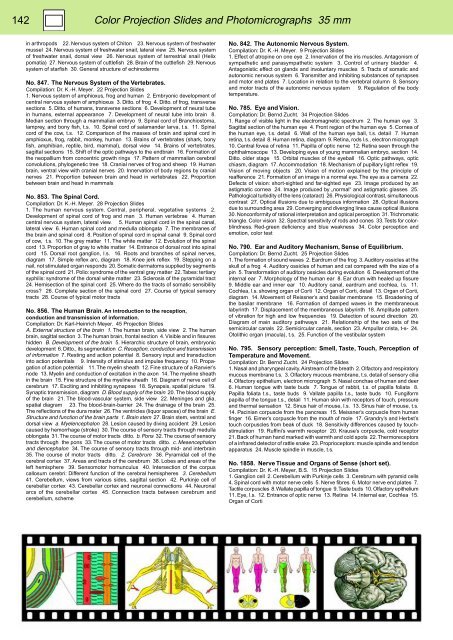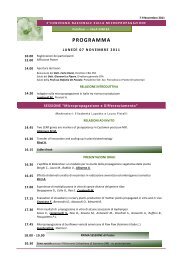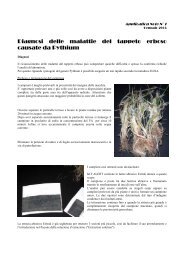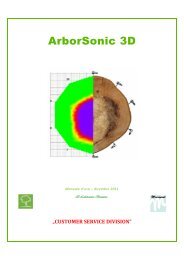BIOLOGY - microscopia.info
BIOLOGY - microscopia.info
BIOLOGY - microscopia.info
Create successful ePaper yourself
Turn your PDF publications into a flip-book with our unique Google optimized e-Paper software.
142<br />
Color Projection Slides and Photomicrographs 35 mm<br />
in arthropods 22. Nervous system of Chiton 23. Nervous system of freshwater<br />
mussel 24. Nervous system of freshwater snail, lateral view 25. Nervous system<br />
of freshwater snail, dorsal view 26. Nervous system of terrestrial snail (Helix<br />
pomatia) 27. Nervous system of cuttlefish 28. Brain of the cuttlefish 29. Nervous<br />
system of starfish 30. General structure of echinoderms<br />
No. 847. The Nervous System of the Vertebrates.<br />
Compilation: Dr. K.-H. Meyer. 22 Projection Slides<br />
1. Nervous system of amphioxus, frog and human 2. Embryonic development of<br />
central nervous system of amphioxus 3. Ditto. of frog 4. Ditto. of frog, transverse<br />
sections 5. Ditto. of humans, transverse sections 6. Development of neural tube<br />
in humans, external appearance 7. Development of neural tube into brain 8.<br />
Median section through a mammalian embryo 9. Spinal cord of Branchiostoma,<br />
lamprey, and bony fish, t.s. 10. Spinal cord of salamander larva, t.s. 11. Spinal<br />
cord of the cow, t.s. 12. Comparison of the masses of brain and spinal cord in<br />
amphioxus, frog, rabbit, monkey, human 13. Brains of vertebrates (shark, bony<br />
fish, amphibian, reptile, bird, mammal), dorsal view 14. Brains of vertebrates,<br />
sagittal sections 15. Shift of the optic pathways to the endbrain 16. Formation of<br />
the neopallium from concentric growth rings 17. Pattern of mammalian cerebral<br />
convolutions, phylogenetic tree 18. Cranial nerves of frog and sheep 19. Human<br />
brain, ventral view with cranial nerves 20. Innervation of body regions by cranial<br />
nerves 21. Proportion between brain and head in vertebrates 22. Proportion<br />
between brain and head in mammals<br />
No. 853. The Spinal Cord.<br />
Compilation: Dr. K.-H. Meyer. 28 Projection Slides<br />
1. The human nervous system. Central, peripheral, vegetative systems 2.<br />
Development of spinal cord of frog and man 3. Human vertebrae 4. Human<br />
central nervous system, lateral view. 5. Human spinal cord in the spinal canal,<br />
lateral view 6. Human spinal cord and medulla oblongata 7. The membranes of<br />
the brain and spinal cord 8. Position of spinal cord in spinal canal 9. Spinal cord<br />
of cow, t.s. 10. The grey matter 11. The white matter 12. Evolution of the spinal<br />
cord 13. Proportion of gray to white matter 14. Entrance of dorsal root into spinal<br />
cord 15. Dorsal root ganglion, l.s. 16. Roots and branches of spinal nerves,<br />
diagram 17. Simple reflex arc, diagram 18. Knee jerk reflex 19. Stepping on a<br />
nail, not stimulated organ responds 20. Somatic dermatoms supplied by segments<br />
of the spinal cord 21. Polio: syndrome of the ventral gray matter 22. Tabes: tertiary<br />
syphilis: syndrome of the dorsal white matter 23. Sclerosis of the pyramidal tract<br />
24. Hemisection of the spinal cord 25. Where do the tracts of somatic sensibility<br />
cross? 26. Complete section of the spinal cord 27. Course of typical sensory<br />
tracts 28. Course of typical motor tracts<br />
No. 856. The Human Brain. An introduction to the reception,<br />
conduction and transmission of <strong>info</strong>rmation.<br />
Compilation: Dr. Karl-Heinrich Meyer. 45 Projection Slides<br />
A. External structure of the brain 1. The human brain, side view 2. The human<br />
brain, sagittal section 3. The human brain, frontal section 4. Visible and in fissures<br />
hidden B. Development of the brain 5. Hierarchic structure of brain, embryonic<br />
development 6. Ditto., its segmentation C. Reception, conduction and transmission<br />
of <strong>info</strong>rmation 7. Resting and action potential 8. Sensory input and transduction<br />
into action potentials 9. Intensity of stimulus and impulse frequency 10. Propagation<br />
of action potential 11. The myelin sheath 12. Fine structure of a Ranvier’s<br />
node 13. Myelin and conduction of excitation in the axon 14. The myeline sheath<br />
in the brain 15. Fine structure of the myeline sheath 16. Diagram of nerve cell of<br />
cerebrum 17. Exciting and inhibiting synapses 18. Synapsis, spatial picture 19.<br />
Synaptic transmission, diagram D. Blood supply of the brain 20. The blood supply<br />
of the brain 21. The blood-vascular system, side view 22. Meninges and glia,<br />
spatial diagram 23. The blood-brain-barrier 24. The drainage of the brain 25.<br />
The reflections of the dura mater 26. The ventricles (liquor spaces) of the brain E.<br />
Structure and function of the brain parts 1. Brain stem 27. Brain stem, ventral and<br />
dorsal view a. Myelencephalon 28. Lesion caused by diving accident 29. Lesion<br />
caused by hemorrhage (stroke) 30. The course of sensory tracts through medulla<br />
oblongata 31. The course of motor tracts ditto. b. Pons 32. The course of sensory<br />
tracts through the pons 33. The course of motor tracts ditto. c. Mesencephalon<br />
and diencephalon 34. The course of sensory tracts through mid- and interbrain<br />
35. The course of motor tracts ditto. 2. Cerebrum 36. Pyramidal cell of the<br />
cerebral cortex 37. Areas and tracts of the cerebrum 38. Lobes and areas of the<br />
left hemisphere 39. Sensomotor homunculus 40. Intersection of the corpus<br />
callosum cerebri: Different function of the cerebral hemispheres 3. Cerebellum<br />
41. Cerebellum, views from various sides, sagittal section 42. Purkinje cell of<br />
cerebellar cortex 43. Cerebellar cortex and neuronal connections 44. Neuronal<br />
arcs of the cerebellar cortex 45. Connection tracts between cerebrum and<br />
cerebellum, scheme<br />
No. 842. The Autonomic Nervous System.<br />
Compilation: Dr. K.-H. Meyer. 9 Projection Slides<br />
1. Effect of atropine on one eye 2. Innervation of the iris muscles. Antagonism of<br />
sympathetic and parasympathetic system 3. Control of urinary bladder 4.<br />
Antagonistic effect on glands and involuntary muscles 5. Tracts of somatic and<br />
autonomic nervous system 6. Transmitter and inhibiting substances of synapses<br />
and motor end plates 7. Location in relation to the vertebral column 8. Sensory<br />
and motor tracts of the autonomic nervous system 9. Regulation of the body<br />
temperature.<br />
No. 785. Eye and Vision.<br />
Compilation: Dr. Bernd Zucht. 34 Projection Slides<br />
1. Range of visible light in the electromagnetic spectrum 2. The human eye 3.<br />
Sagittal section of the human eye 4. Front region of the human eye 5. Cornea of<br />
the human eye, t.s. detail 6. Wall of the human eye ball, t.s. detail 7. Human<br />
retina, t.s. detail 8. Human retina, diagram 9. Retina, rods l.s., electron micrograph<br />
10. Central fovea of retina 11. Papilla of optic nerve 12. Retina seen through the<br />
ophthalmoscope 13. Developing eyes of young mammalian embryo, section 14.<br />
Ditto. older stage 15. Orbital muscles of the eyeball 16. Optic pathways, optic<br />
chiasm, diagram 17. Accommodation 18. Mechanism of pupillary light reflex 19.<br />
Vision of moving objects 20. Vision of motion explained by the principle of<br />
reafference 21. Formation of an image in a normal eye. The eye as a camera 22.<br />
Defects of vision: short-sighted and far-sighted eye 23. Image produced by an<br />
astigmatic cornea 24. Image produced by „normal“ and astigmatic glasses 25.<br />
Pathological turbidity of the lens (cataract) 26. Physiological contrast, simultaneous<br />
contrast 27. Optical illusions due to ambiguous <strong>info</strong>rmation 28. Optical illusions<br />
due to surrounding area 29. Converging and diverging lines cause optical illusions<br />
30. Nonconformity of rational interpretation and optical perception 31. Trichromatic<br />
triangle. Color vision 32. Spectral sensitivity of rods and cones 33. Tests for colorblindness.<br />
Red-green deficiency and blue weakness 34. Color perception and<br />
emotion, color test<br />
No. 790. Ear and Auditory Mechanism, Sense of Equilibrium.<br />
Compilation: Dr. Bernd Zucht. 25 Projection Slides<br />
1. The formation of sound waves 2. Eardrum of the frog 3. Auditory ossicles at the<br />
skull of a frog 4. Auditory ossicles of human and cat compared with the size of a<br />
pin 5. Transformation of auditory ossicles during evolution 6. Development of the<br />
internal ear 7. Morphology of the human ear 8. Ear drum with healed up fissure<br />
9. Middle ear and inner ear 10. Auditory canal, eardrum and cochlea, l.s. 11.<br />
Cochlea, l.s. showing organ of Corti 12. Organ of Corti, detail 13. Organ of Corti,<br />
diagram 14. Movement of Reissner’s and basilar membrane 15. Broadening of<br />
the basilar membrane 16. Formation of damped waves in the membraneous<br />
labyrinth 17. Displacement of the membraneous labyrinth 18. Amplitude pattern<br />
of vibration for high and low frequencies 19. Detection of sound direction 20.<br />
Diagram of main auditory pathways 21. Relationship of the two sets of the<br />
semicircular canals 22. Semicircular canals, section 23. Ampullar crista, t-s- 24.<br />
Otolithic organ (macula), t.s. 25. Function of the vestibular system<br />
No. 795. Sensory perception: Smell, Taste, Touch, Perception of<br />
Temperature and Movement.<br />
Compilation: Dr. Bernd Zucht. 24 Projection Slides<br />
1. Nasal and pharyngeal cavity. Airstream of the breath 2. Olfactory and respiratory<br />
mucous membrane t.s. 3. Olfactory mucous membrane, t.s. detail of sensory cilia<br />
4. Olfactory epithelium, electron micrograph 5. Nasal conchae of human and deer<br />
6. Human tongue with taste buds 7. Tongue of rabbit, t.s. of papilla foliata 8.<br />
Papilla foliata t.s., taste buds 9. Vallate papilla t.s., taste buds 10. Fungiform<br />
papilla of the tongue t.s., detail 11. Human skin with receptors of touch, pressure<br />
and thermal sensation 12. Sinus hair of mouse, l.s. 13. Sinus hair of mouse, t.s.<br />
14. Pacinian corpuscle from the pancreas 15. Meissner’s corpuscle from human<br />
finger 16. Eimer’s corpuscle from the mouth of mole 17. Grandry’s and Herbst’s<br />
touch corpuscles from beak of duck 18. Sensitivity differences caused by touchstimulation<br />
19. Ruffini’s warmth receptor 20. Krause’s corpuscle, cold receptor<br />
21. Back of human hand marked with warmth and cold spots 22. Thermoreceptors<br />
of a infrared detector of rattle snake 23. Proprioceptors: muscle spindle and tendon<br />
apparatus 24. Muscle spindle in muscle, t.s.<br />
No. 1858. Nerve Tissue and Organs of Sense (short set).<br />
Compilation: Dr. K.-H. Meyer, B.S. 15 Projection Slides<br />
1. Ganglion cell 2. Cerebellum with Purkinje cells 3. Cerebrum with pyramid cells<br />
4. Spinal cord with motor nerve cells 5. Nerve fibres 6. Motor nerve end plates 7.<br />
Tactile corpuscles 8. Wallate papilla of tongue 9. Taste buds 10. Olfactory epithelium<br />
11. Eye, l.s. 12. Entrance of optic nerve 13. Retina 14. Internal ear, Cochlea 15.<br />
Organ of Corti







